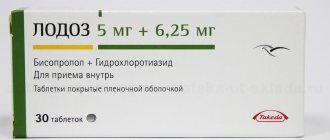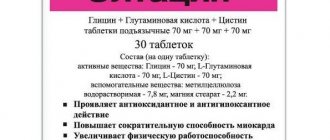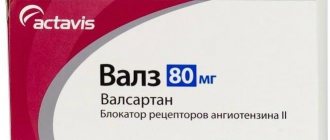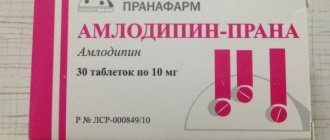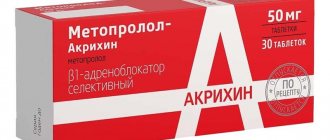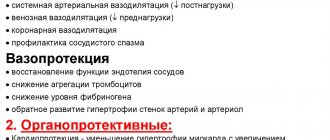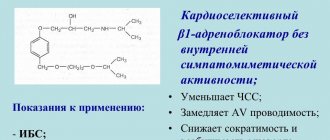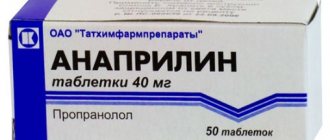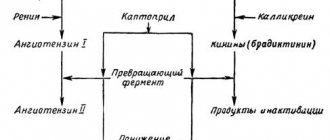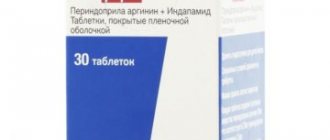- July 29, 2019
- Cardiology
- Svetlana Pavlova
Various medications are used in medical practice to treat hypertension. In recent years, combination medications have proven themselves to be effective. The combination of several active ingredients in one tablet can significantly reduce adverse events and enhance the therapeutic effect of the drug. An ACE inhibitor and a calcium antagonist, present in adequate dosages in one dosage form, complement each other and work together for a common result. Their action is described in detail in the instructions for use. "Equacard" is an effective remedy that perfectly reduces blood pressure and has a long-term therapeutic effect in patients with serious heart pathologies. Medical professionals recommend it for regular use to treat persistent high blood pressure. And also for those individuals who prefer to take combined drugs.
When using it, you should remember that the tablets can cause drowsiness and dizziness, so it is undesirable to drive a vehicle, and in addition, it is dangerous to perform certain types of work that require increased concentration.
Active ingredients
Equacard contains two active components, thanks to which the occurrence of side effects is minimized:
- Lisinopril - slows down the action of angiotensin-converting enzyme. It reduces the creation of biologically active octapeptide II from angiotonin I. As a result, bradykinin regression and aldosterone release are reduced, and lipid production increases. As a result, total peripheral vascular resistance, blood pressure, preload, and pulmonary capillary pressure fall. In addition, lisinopril dilates arteries to a greater extent, as opposed to veins. With long-term use, hypertrophy of the heart muscle and arterial walls of the resistant type decreases. The blood supply to the myocardium improves. The life expectancy of individuals suffering from heart failure in the chronic stage increases, the progression of left ventricular dysfunction slows down in individuals who have suffered a myocardial infarction without symptoms of heart failure.
- Amlodipine belongs to the group of calcium channel blockers. It exhibits antihypertensive and antianginal effects and closes calcium channels. By expanding the coronary vessels in the affected and unaltered areas of the myocardium, it increases the penetration of oxygen into it. Reduces the severity of myocardial ischemia. Has a long-term antihypertensive effect.
According to the instructions for use, Equacard begins to have maximum effect six hours after administration. Moreover, the duration of the antihypertensive effect lasts for 24 hours. This feature is very significant, as it allows individuals to take a tablet just once a day. Thanks to the combination of two active components, physical endurance increases in people with chronic heart failure or angina pectoris.
Pharmacokinetics
Processes such as absorption, distribution, deposition, conversion and excretion of two active drug substances occur without pharmacokinetic interaction. At the same time, eating food does not have any effect on the absorption of the drug "Equacard". Due to its long-term circulation in the individual’s body, tablets are taken only once a day. Let's consider these pharmacokinetic processes using the example of active substances:
- Lisinopril is absorbed from the gastrointestinal tract about twenty-five percent. Peak concentration occurs seven hours after taking the medication. It binds insignificantly to blood plasma proteins. The substance does not undergo biotransformation in the individual’s body. It has low permeability through the placental and blood-brain barrier. Excreted unchanged by the kidneys. The bioavailability of the substance in persons with chronic heart failure is sixteen percent. In addition, it is reduced by thirty percent in patients with serious liver disease (cirrhosis) compared to individuals with a healthy organ.
- Amlodipine is absorbed slowly from the gastrointestinal tract. After six to nine hours, the maximum concentration in the blood serum is reached. The accumulation of the drug occurs within eight days from the start of therapy. Food intake does not affect its absorption. Most of the medication is found in the tissues, and less in the bloodstream. About ninety-five percent of amlodipine in the blood is bound to plasma proteins. It undergoes slow metabolism in the liver. The dose taken is excreted from the individual’s body: sixty percent by the kidneys in the form of metabolites, ten percent unchanged, about twenty percent with bile. Compared to young patients, the elimination of this component is slower in older patients. In addition, it is able to penetrate the blood-brain barrier.
Instructions for Equacard (tablets)
- home
- Instructions for Equacard (tablets)
< Return to previous page
Name: Equacard Release form: tablets Dosage: 5 mg+10 mg; 5 mg+5 mg; INN: Amlodipine + Lisinopril ATC code: C09BB03 Group: Drugs for the treatment of diseases of the cardiovascular system Subgroup: Drugs affecting the renin-angiotensin system Pharmaceutical group: ACE inhibitors in combination with other drugs Pharmaceutical subgroup: ACE inhibitors in combination with BMCC
Characteristics: Release form, composition Equacard tablets, pink, round, flat-cylindrical, chamfered, with a score on one side. 1 tab. - amlodipine 5 mg - lisinopril 5 mg Excipients: lactose 106.34 mg, corn starch 58.86 mg, povidone 5.7 mg, talc 3.8 mg, magnesium stearate 1.95 mg, crimson dye (Ponceau 4R) 0.1 mg.
Equacard tablets are white, round, flat-cylindrical, chamfered, with a score on one side. 1 tab. - amlodipine 5 mg - lisinopril 10 mg Excipients: lactose 100.625 mg, corn starch 58.66 mg, povidone 5.7 mg, talc 3.8 mg, magnesium stearate 2 mg. Pharmaceutical group: Antihypertensive drug. Pharmaceutical action: Equacard is a combination drug containing the active ingredients: lisinopril and amlodipine. Lisinopril: An angiotensin-converting enzyme (ACE) inhibitor, reduces the formation of angiotensin II from angiotensin I. The decrease in angiotensin II leads to a direct decrease in the release of aldosterone. Reduces the degradation of bradykinin and increases the synthesis of prostaglandins. Reduces total peripheral vascular resistance (TPVR), blood pressure, preload, pressure in the pulmonary capillaries, causes an increase in minute blood volume and an increase in myocardial tolerance to stress in patients with chronic heart failure. Dilates arteries more than veins. Some effects have been attributed to effects on the renin-angiotensin-aldosterone system (RALS). With long-term use, hypertrophy of the myocardium and the walls of resistive arteries decreases. Improves blood supply to ischemic myocardium. ACE inhibitors extend life expectancy in patients with chronic heart failure and slow the progression of left ventricular dysfunction in patients who have suffered acute myocardial infarction without clinical manifestations of heart failure. The onset of action of the drug is after 1 hour, the maximum antihypertensive effect is achieved after 6-7 hours and lasts for 24 hours. The duration of the effect also depends on the size of the dose taken. In arterial hypertension, the effect is observed in the first days after the start of treatment, a stable effect develops after 1-2 months of therapy. When lisinopril was abruptly discontinued, no significant increase in blood pressure was observed. Lisinopril reduces albuminuria. Does not affect the concentration of glucose in the blood in patients with diabetes and does not lead to an increase in cases of hypoglycemia. Amlodipine: A blocker of “slow” calcium channels, a dihydropyridine derivative, a blocker of “slow” calcium channels (SCBC), has an antianginal and antihypertensive effect, blocks calcium channels, reduces the granomembrane transition of calcium ions into the cell (more into vascular smooth muscle cells than into cardiomyocytes ). The antianginal effect is due to the expansion of the coronary and peripheral arteries and arterioles: in case of angina pectoris, it reduces the severity of myocardial ischemia; by expanding peripheral arterioles, it reduces peripheral vascular resistance, reduces afterload on the heart, and reduces myocardial oxygen demand. By expanding the coronary arteries and arterioles in unchanged and ischemic areas of the myocardium, it increases the supply of oxygen to the myocardium (especially with vasospastic angina); prevents spasm of the coronary arteries (including those caused by smoking). In patients with stable angina, a single daily dose increases exercise tolerance, increases the time before the onset of an angina attack and “ischemic” depression of the ST segment, reduces the frequency of angina attacks and the consumption of nitroglycerin and other nitrates. It has a long-term dose-dependent antihypertensive effect. The antihypertensive effect is due to a direct vasodilating effect on vascular smooth muscle. For arterial hypertension, a single dose provides a clinically significant reduction in blood pressure over 24 hours (in the patient’s “lying” and “standing” position). Orthostatic hypotension when prescribing amlodipine is quite rare. Does not cause a decrease in left ventricular ejection fraction. Reduces the degree of left ventricular myocardial hypertrophy. It has no effect on myocardial contractility and conductivity, does not cause a reflex increase in heart rate, inhibits platelet aggregation, increases the glomerular filtration rate, and has a weak natriuretic effect. In diabetic nephropathy, it does not increase the severity of microalbumiuria. It does not have any adverse effect on metabolism and plasma lipid concentrations and can be used in the treatment of patients with bronchial asthma, diabetes mellitus and gout. A significant decrease in blood pressure is observed after 6-10 hours, the duration of the effect is 24 hours. Equacard: The combination of lisinopril with amlodipine in one drug helps prevent the development of possible undesirable effects caused by counterregulation of any of the active substances. Thus, a blocker of “slow” calcium channels, directly dilating arterioles, can lead to sodium and fluid retention in the body, etc. therefore, may activate the RAAS. An ACE inhibitor blocks this process and normalizes reactions to salt load. Pharmacokinetics: Lisinopril: After oral administration, lisinopril is absorbed from the gastrointestinal tract by an average of 25%, but absorption can vary from 6 to 60%. Bioavailability is 29%. Cmax in blood plasma is reached after 7 hours. Food intake does not affect the absorption of lisinopril. Lisinopril is slightly bound to plasma proteins. Permeability through the blood-brain and placental barrier is low. Lisinopril is not biotransformed in the body. It is excreted unchanged by the kidneys. T1/2 is 12.6 hours. Lisinopril clearance is 50 ml/min. The decrease in serum concentration of lisinopril occurs in two phases. In patients with chronic heart failure, absorption and clearance of lisinopril are reduced, bioavailability is 16%. In patients with renal failure (creatinine clearance (CC) less than 30 ml/min), the concentration of lisinopril is several times higher than the concentration in the blood plasma of healthy volunteers, and there is an increase in the time to reach Cmax in the blood plasma and an increase in T1/2. In elderly patients, Cmax of the drug in blood plasma and AUC are 2 times higher than in young patients. In patients with liver cirrhosis, the bioavailability of lisinopril is reduced by 30% and clearance by 50% compared to patients with normal liver function. In elderly patients, the concentration of lisinopril in the blood is increased by an average of 60%. Amlodipine: After oral administration, amlodipine is slowly absorbed from the gastrointestinal tract. The average absolute bioavailability is 64%, Cmax in the blood serum is observed after 6-9 hours. Equilibrium concentrations (Css) are achieved after 7-8 days of therapy. Food intake does not affect the absorption of amlodipip. The average Vd is 21 l/kg body weight, which indicates that most of the drug is in the tissues and less in the blood. Most of the amlodipine found in the blood (95%) is bound to plasma proteins. Amlodipine undergoes slow but active metabolism in the liver with no significant first-pass effect. Metabolites do not have significant pharmacological activity. After a single oral dose, T1/2 varies from 35 to 50 hours; with repeated use, T1/2 is approximately 45 hours. About 60% of the dose taken orally is excreted by the kidneys mainly in the form of metabolites, 10% unchanged, and 20-25 % through the intestines with bile. The total clearance of amlodipine is 0.116 ml/s/kg (7 ml/min/kg, 0.42 l/h/kg). In elderly patients (over 65 years of age), the elimination of amlodipine is slower (T1/2 is 65 hours) compared to young patients, but this difference is not clinically significant. Prolongation of T1/2 in patients with liver failure suggests that with long-term use the accumulation of the drug in the body will be higher (T1/2 up to 60 hours). Renal failure does not significantly affect the kinetics of amlodipine. In patients with impaired renal function, changes in amlodipine concentrations and blood plasma do not correlate with the degree of renal failure. A slight increase in T1/2 is possible. Amlodipine penetrates the blood-brain barrier. It is not removed by hemodialysis. Equacard: Pharmacokinetic interaction between the active substances included in the drug is unlikely. AUC, time to reach and values of Cmax, T1/2 do not change compared to the indicators of each individual active substance. Eating does not affect the absorption of active substances. Long-term circulation of both active ingredients in the body makes it possible to take the drug once a day. Indications: Essential hypertension when combination therapy is necessary. Category of effect on the fetus: The use of Equacard® is not recommended during pregnancy. If pregnancy is diagnosed, taking Equacard® should be stopped as soon as possible. Taking ACE inhibitors in the second and third trimester of pregnancy has an adverse effect on the fetus (a marked decrease in blood pressure, renal failure, hyperkalemia, hypoplasia of the skull bones, and intrauterine death are possible). There is no data on the negative effects of the drug on the fetus when used during the first trimester. For newborns and infants who have been exposed in utero to ACE inhibitors, it is recommended to conduct careful monitoring for timely detection of a pronounced decrease in blood pressure, oliguria, and hyperkalemia. The safety of amlodipine during pregnancy has not been established; therefore, use during pregnancy is possible only when the benefit to the mother outweighs the potential risk to the fetus. Lisinopril crosses the placenta. There is no data on the penetration of lisinopril into breast milk. There is no data indicating the excretion of amlodipine into breast milk. However, it is known that other BMCCs, dihydropyridine derivatives, are excreted in breast milk. The use of Equacard® during breastfeeding is not recommended. If the use of the drug is necessary during lactation, then breastfeeding must be stopped. Contraindications: - hypersensitivity to any of the components of the drug Equacard or to other dihydropyridine derivatives, other ACE inhibitors; - history of angioedema, including those caused by the use of other ACE inhibitors; - hereditary and/or idiopathic angioedema; - hemodynamically significant stenosis of the aorta or mitral valve or hypertrophic obstructive cardiomyopathy; - severe arterial hypotension (systolic blood pressure less than 90 mm Hg); - cardiogenic shock; — pregnancy, lactation period; — age up to 18 years; - acute myocardial infarction (within the first 28 days), unstable angina (with the exception of Prinzmetal's angina); - lactose intolerance, lactose deficiency and glucose-galactose malabsorption. Caution: Cerebrovascular diseases (including cerebrovascular insufficiency), coronary artery disease, coronary insufficiency, arterial hypotension, systemic connective tissue diseases (including scleroderma, systemic lupus erythematosus), suppression of bone marrow hematopoiesis, hyperkalemia, condition after kidney transplantation , renal and/or liver failure, sick sinus syndrome (severe bradycardia, tachycardia), chronic heart failure of non-ischemic etiology of functional class III-IV according to the NYHA classification, heart failure in the stage of decompensation, aortic stenosis, mitral stenosis, acute myocardial infarction (after first 28 days), old age, bilateral renal artery stenosis or stenosis of the artery of a single kidney with progressive azotemia, hemodialysis using high-flow dialysis membranes (AN69®), azotemia, primary hyperaldosteronism, conditions accompanied by a decrease in circulating blood volume (CBV) (including including as a result of diarrhea, vomiting); use in patients on a salt-restricted diet. Dosage: Equacard® tablets are taken orally once a day, regardless of meal time, with a sufficient amount of liquid. Adults: The recommended dose is 1 tablet of Equacard® 1 time per day. At the beginning of therapy with Equacard®, symptomatic arterial hypotension may develop, which more often occurs in patients with fluid and electrolyte imbalance due to previous diuretic therapy. Diuretics should be discontinued 2-3 days before starting therapy with Equacard®. In cases where withdrawal of diuretics is impossible, the initial dose of Equacard® is 1/2 tablet (5 mg + 5 mg) 1 time / day, after taking which, the patient should be monitored for several hours due to the possible development of symptomatic arterial hypotension. Impaired renal function: In patients with impaired renal function, it is recommended to use the drug Equacard® at a dose of 5 mg + 5 mg (increased T1/2 of lisinopril). The maintenance dose is selected depending on the tolerability of the therapy; monitoring of renal function, potassium and sodium levels in the blood plasma is required. Liver dysfunction: In patients with liver dysfunction, it is recommended to use the drug Equacard® at a dose of 5 mg + 5 mg (increased T1/2 of amlodipine). Side effects: The frequency of the adverse reactions listed below was determined according to the following (World Health Organization classification): very often - at least 10%; often - at least 1%, but less than 10%; infrequently - not less than 0.1%, but less than 1%; rarely - not less than 0.01%, but less than 0.1%; very rarely - less than 0.01%, including individual messages. Lisinopril: From the cardiovascular system: often - marked decrease in blood pressure, orthostatic hypotension; uncommon - acute myocardial infarction, tachycardia, palpitations; Raynaud's syndrome; rarely – bradycardia, tachycardia, worsening symptoms of chronic heart failure, atrioventricular conduction disturbance, chest pain. From the side of the central nervous system: often - dizziness, headache; uncommon - mood lability, paresthesia, sleep disturbances, stroke; rarely - confusion, asthenic syndrome, convulsive twitching of the muscles of the limbs and lips, drowsiness. From the hematopoietic and lymphatic systems: rarely - decrease in hemoglobin, hematocrit; very rarely - leukopenia, neutropenia, agranulocytosis, thrombocytopenia, eosinophilia, erythropenia, hemolytic anemia, lymphadenopathy, autoimmune diseases. From the respiratory system: often – cough; infrequently – rhinitis; very rarely - sinusitis, bronchospasm, allergic alveolitis/eosinophilic pneumonia, shortness of breath. From the digestive system: often - diarrhea, vomiting; uncommon - dyspepsia, taste changes, abdominal pain; rarely - dryness of the oral mucosa; very rarely - pancreatitis, jaundice (hepatocellular or cholestatic), hepatitis, liver failure, interstitial edema, anorexia. From the skin: infrequently - itching, rash; rarely - angioedema of the face, limbs, lips, tongue, larynx, urticaria, alopecia, psoriasis; very rarely - increased sweating, vasculitis, pemphigus, photosensitivity, toxic epidermal necrolysis (Lyell's syndrome), erythema multiforme, Stevens-Johnson syndrome. From the urinary system: often - impaired renal function; uncommon - uremia, acute renal failure; very rarely - anuria, oliguria, proteinuria. From the reproductive system: infrequently - impotence, rarely - gynecomastia. Metabolic disorders: very rarely - hypoglycemia. From laboratory parameters: infrequently - increased concentration of urea in the blood, hypercreatininemia, hyperkalemia, increased activity of “liver” transaminases, rarely - hyperbilirubinemia, hyponatremia, increased erythrocyte sedimentation rate, false-positive test results for antinuclear antibodies. From the musculoskeletal system: rarely - arthralgia/arthritis, myalgia. Amlodipine: From the side of the central nervous system: often - headache (especially at the beginning of treatment), dizziness, increased fatigue, runny nose; uncommon - general malaise, hypoesthesia, asthenia, paresthesia, peripheral neuropathy, tremor, insomnia, emotional lability, unusual dreams, nervousness, increased excitability, depression, anxiety, increased sweating; rarely - convulsions, apathy, agitation; very rarely - ataxia, amnesia. From the digestive system: often - nausea, abdominal pain; uncommon - vomiting, change in bowel habits (including constipation, flatulence), dyspepsia, diarrhea, anorexia, dry oral mucosa, thirst; rarely - gum hyperplasia, increased appetite; very rarely - pancreatitis, gastritis, jaundice (usually cholestatic), hyperbilirubinemia, increased activity of liver transaminases, hepatitis. From the cardiovascular system: often - peripheral edema (ankles and feet), palpitations, “flushes” of blood to the skin of the face; uncommon - excessive decrease in blood pressure, orthostatic hypotension, vasculitis; rarely - development or worsening of chronic heart failure; very rarely - fainting, shortness of breath, cardiac arrhythmias (including bradycardia, ventricular tachycardia and atrial fibrillation), myocardial infarction, chest pain, pulmonary edema, migraine. From the hematopoietic and lymphatic systems: very rarely - thrombocytopenic purpura, leukopenia, thrombocytopenia. From the urinary system: infrequently - pollakiuria, painful urge to urinate, nocturia; very rarely - dysuria, polyuria. From the reproductive system and mammary glands: infrequently - gynecomastia, impotence. From the respiratory system: infrequently - shortness of breath, rhinitis; very rarely - cough. From the musculoskeletal system: infrequently - muscle cramps, myalgia. arthralgia, back pain, arthrosis; rarely - myasthenia. From the skin: infrequently - alopecia; rarely - dermatitis; very rarely - alopecia, xeroderma, cold sticky sweat, skin pigmentation disorder. Allergic reactions: rarely - skin itching, rash (including erythematous, maculopapular rash); very rarely - urticaria, angioedema, erythema multiforme. From the senses: infrequently - ringing in the ears, blurred vision, diplopia, impaired accommodation, xerophthalmia, conjunctivitis, eye pain; very rarely - parosmia. Metabolism: very rarely - hyperglycemia. Other: uncommon - weight loss, weight gain, taste disturbance, nosebleeds, chills. Overdose: Lisinopril: Symptoms: marked decrease in blood pressure, dryness of the oral mucosa, water-electrolyte imbalance, renal failure, increased breathing, tachycardia, palpitations, bradycardia, dizziness, anxiety, increased irritability, cough, drowsiness, urinary retention, constipation. Treatment: there is no specific antidote. Gastric lavage, use of enterosorbents and laxatives. Intravenous administration of 0.9% sodium chloride solution is indicated. In case of treatment-resistant bradycardia, the use of an artificial pacemaker is necessary. Monitoring of blood pressure and water and electrolyte balance is necessary. Hemodialysis is effective. Amlodipine: Symptoms: marked decrease in blood pressure with the possible development of reflex tachycardia and excessive peripheral vasodilation (risk of severe and persistent arterial hypotension, including the development of shock and death). Treatment: gastric lavage, use of activated charcoal (especially in the first 2 hours after an overdose), maintaining the function of the cardiovascular system, elevated position of the lower extremities, monitoring heart and lung performance, monitoring circulating blood volume (CBV) and diuresis. To restore vascular tone, use vasoconstrictors (in the absence of contraindications to their use); to eliminate the effects of calcium channel blockade, intravenous administration of calcium gluconate. Hemodialysis is not effective. Interaction: Lisinopril: Lisinopril should be used with caution simultaneously with potassium-sparing diuretics (spironolactone, triamterene, amiloride, eplerenone), potassium supplements, salt substitutes containing potassium, cyclosporine - the risk of hyperkalemia increases, especially with impaired renal function. Therefore, these combinations should be used only on the basis of an individual physician’s decision with regular monitoring of serum potassium levels and renal function. With simultaneous use with diuretics and other hypotensive agents, the antihypertensive effect of lysinopril intensifies. With the simultaneous use with non-steroidal anti-inflammatory drugs (NSAIDs) (including selective inhibitors of cyclooxygenase-2 (COG-2)), estrogens, as well as sympathomy, the antihypertensive effect of lysinopril decreases. NSAIDs, including TSOG-2, and ACE inhibitors increase the potassium content in blood serum and can worsen the function of the kidneys. We usually turn this effect. Lisinopril slows down lithium drugs, therefore, when used simultaneously, there is an reversible increase in its concentration in blood plasma, which can increase the likelihood of developing undesirable phenomena, so you should regularly monitor the concentration of lithium in the blood serum. With the simultaneous use with antacids and wheels with tirah, the absorption of Lizinopril from LCDs is reduced. Ethanol enhances the action of lysinopril. With simultaneous use with insulin and hypoglycemic agents for oral administration, the risk of hypoglycemia increases. With the simultaneous use of lysinopril with vasodilators, barbiturates, antipsychotic agents (antipsychotics), tricyclic antidepressants. BMCK, beta-blockers can increase the antihypertensive effect. With the simultaneous use of ACE inhibitors and gold (sodium aurotiamalat), a symptom complex is described, including facial hyperemia, nausea, vomiting and reduction of blood pressure. Joint use with allopurinol, prokaamine, cytostatics can lead to leukopenia. Amlodipine: amlodipine can safely be used for arterial hypertension therapy along with thiazide diuretics, alpha-blockers or ACE inhibitors. Unlike other BMCCs, the clinically significant interaction of amlodipine was not found with joint use with NSAIDs, including indomethacin. It is possible to strengthen the antianginal and hypotensive effect of BMCC when jointly used with thiazide and “loop” diuretics, ACE inhibitors and nitrates, as well as strengthening their antihypertensive effects with the simultaneous use of alpha1 -adreno -blockers. Erythromycin, with joint use, increases CMAX amlodipine in young patients by 22%, and in elderly patients - by 50%. Beta-blockers with simultaneous use with amlodipin can be caused, exacerbation of the course of chronic heart failure. Although negative inotropic effects have generally not been observed in amlodipine studies, some CBMCs may enhance the negative inotropic effects of antiarrhythmic drugs that prolong the QT interval (eg, amiodarone and quinidine). A single intake of 100 mg of sildenafil in patients with arterial hypertension does not affect the parameters of amlodipine pharmacokinetics. The preventive use of amlodipine at a dose of 10 mg and atorvastatin at a dose of 80 mg is not accompanied by significant changes in the indicators of pharmacokinetics of atorvastatin. Ethanol (drinks containing alcohol): amlodipine with single and repeated use in a dose of 10 mg does not affect the pharmacokinetics of ethanol. Antirerovirus agents (ritonavir) increases the plasma concentrations of BMCC, including amlodipine. Enormalpluenza of the hypotensive effect of dihydropyridine derivatives and isofluran. Calcium preparations can reduce the effect of BMCC. With the joint use of amlodipine with lithium preparations, it is possible to increase the manifestation of neurotoxicity (nausea, vomiting, diarrhea, ataxia, tremor, noise and ears). Amlodipine does not change the pharmacokinetics of cyclosporin. Does not affect the serum concentration of digoxin and its renal clearance. It does not have a significant impact on the action of warfarin (prothrombin time). Cimetidine does not affect the pharmacokinetics of amlodipine. In vitro studies, amlodipine does not affect the binding of blood, digoxin, phenytein, warfarin and indomethacin plasma proteins. Grapefruit juice: simultaneous single administration of 240 mg of grapefruit juice and 10 mg of amlodipine orally is not accompanied by a significant change in the pharmacokinetics of amlodipine. Aluminum or magnesium-containing antacids: their single intake does not have a significant effect on amlodipine pharmacokinetics. Special instructions: Treatment with Ekvakard® can begin only after correction of hyponatremia and restoration of the volume of circulating blood. After taking the first dose of the drug, careful control of blood pressure is recommended, a significant decrease in blood pressure with the development of symptomatic arterial hypotension is possible. Most often, a pronounced decrease in blood pressure occurs with a decrease in the OCC caused by therapy with diuretics, a decrease in the content of table salt in food, dialysis, diarrhea or vomiting. With arterial hypotension, the patient is given a horizontal position and, if necessary, in/V is introduced a solution that replenishes the volume of the circulating fluid (infusion of 0.9% sodium chloride solution). Similar rules should be adhered to when using the drug Equakard® patients with coronary heart disease, cerebrovascular failure, in which a sharp decrease in blood pressure can lead to myocardial infarction or stroke. With aortic stenosis, hypertrophic obstructive cardiomyopathy, the purpose of the vasodilator requires caution. During the therapy period, Ekvakard® must control body weight and salt consumption, the purpose of the corresponding diet is shown. It is necessary to maintain the hygiene of the oral cavity and observe the dentist (to prevent pain, bleeding and gum hyperplasia). During the period of therapy, periodic monitoring of peripheral blood is necessary, because The potential risk of agranulocytosis cannot be excluded, periodic monitoring of peripheral blood is required. In case of impaired renal function, for example, with stenosis of the renal artery (especially with bilateral or stenosis of the arteries of the only kidney), hyponatremia, dehydration, blood circulation insufficiency, the drug’s deterioration can provoke an acute renal failure, reversible after the treatment of treatment. It is necessary to control patients with impaired renal function. In elderly patients, T1/2 amlodipine may increase and the clearance of the drug decrease. More careful monitoring of patients of this category is necessary. In case of impaired liver function, the half -life of amlodipine increases, such patients are prescribed with caution, after assessing the benefits and risk. With the use of ACE inhibitors, the development of angioedaurotic edema of the face, limbs, lips, tongue, nastratan or larynx, requiring immediate cessation of treatment with the drug and establishing medical monitoring until complete regression of symptoms, is possible. Angioneurotic edema with edema of the larynx can be fatal. The swelling of the tongue, the dome or larynx can cause the obstruction of the respiratory tract, so it is necessary to immediately carry out the appropriate therapy (0.3-0.5 ml of 1: 1000 solution of epinephrine (adrenaline) s/c) and/or measures to ensure the patency of the respiratory tract. In cases where edema is localized only on the face and lips, the condition most often takes place without treatment, but it is possible to use antihistamines. The risk of developing angioedemic edema increases in patients who have an anamnesis of angioedema from the use of ACE inhibitors. In patients taking ACE inhibitors during the desensitization procedure for the venom of webding, it is extremely rare, anaphylactoid reactions can develop. This can be avoided if you temporarily stop treatment with the ACE inhibitor before each desensitization procedure for the hymenopter. Surgical intervention/General anesthesia: when using means for general anesthesia with antihypertensive effects and during extensive surgical interventions, Lizinopril inhibits the formation of angiotensin-II in response to compensatory release of renin. With such arterial hypotension, blood pressure is normalized by increasing the volume of circulating blood. Before surgery (including dental surgery), a surgeon/anesthetist should be informed about the use of ACE inhibitor. Anaphylactoid reactions are also noted in patients on hemodialysis using high -per -flow dialysis membranes (AN69®), who simultaneously take ACE inhibitors. In such cases, it is necessary to consider the possibility of using another type of membrane for dialysis or other hypotensive agent. When selecting the dose, it should be borne in mind that in elderly patients, both active substances are determined in the blood in a greater concentration, while the effectiveness does not change. When using ACE inhibitors, a cough was noted. The cough is dry, prolonged, which disappears after the cessation of treatment with ACE inhibitor. With a differential diagnosis of cough, it is necessary to take into account the cough caused by the use of the inhibitor of the APF. The impact on the ability to drive vehicles and mechanisms: caution should be observed when taking the drug Ekvakard® due to the fact that it is possible to develop arterial hypotension, dizziness and drowsiness, which may affect the ability to drive vehicles and work with potentially dangerous mechanisms.
< Return to previous page
Adverse reactions
During the period of clinical studies, the following side effects of Equacard were identified on the part of some systems of the individual’s body:
- Cardiovascular - orthostatic hypotension, tachycardia, sensation of heartbeat, acute myocardial infarction, bradycardia, pain in the chest area, failure of atrioventricular conduction, swelling of the lower extremities, severe decrease in pressure, the occurrence of heart failure, and if existing - aggravation of its course, failure heart rate, shortness of breath, pulmonary edema, fainting.
- Digestive - vomiting, dyspepsia, diarrhea, dry mouth, change in taste, abdominal pain, jaundice, hepatitis, pancreatitis, anorexia, liver failure, interstitial edema, constipation, thirst, gastritis, increased appetite, flatulence.
- Respiratory – cough, shortness of breath, runny nose, sinusitis, pneumonia, shortness of breath, bronchospasm, allergic alveolitis.
- Lymphatic and hematopoiesis - leukopenia, agranulocytosis, thrombocytopenia, decreased hemoglobin, neutropenia, eosinophilia, lymphadenopathy, autoimmune diseases.
- Central nervous system - headache, fatigue, dizziness, asthenia, tremor, insomnia, nervousness, increased excitability, convulsions, depression, increased sweating, paresthesia, neuropathy, frequent mood swings, stroke, confusion, twitching of the muscles of the limbs and lips like convulsions .
- Urinary – kidney failure, acute renal failure, proteinuria, painful urge to urinate.
- Reproductive – impotence, gynecomastia.
According to the instructions for use, Equacard can provoke visual impairment and accommodation, conjunctivitis, eye pain, myalgia, arthritis, muscle cramps, myasthenia gravis, urticaria, rash, dermatitis, nosebleeds, chills, weight loss.
In addition, according to the results of laboratory parameters, cases of increased ESR, concentrations of potassium, urine, creatinine in the blood, activity of liver transaminases, as well as the phenomenon of hyponatremia and hyperbilirubinemia were recorded.
Equacard tablets 5mg+5mg No. 30
Interaction
The frequency of the adverse reactions listed below was determined according to the following (World Health Organization classification): very often - at least 10%, often at least 1% but less than 10%, infrequently at least 0.1% but less than 1%, rarely not less than 0.01%, but less than 0.1%, very rarely less than 0.01%, including individual messages.
Lisinopril
From the cardiovascular system:
often a pronounced decrease in blood pressure. orthostatic hypotension, infrequently acute myocardial infarction, tachycardia, palpitations, Raynaud's syndrome, rarely bradycardia, tachycardia, aggravation of symptoms of CSI, impaired atrioventricular conduction, chest pain.
From the central nervous system:
often dizziness, headache, infrequently mood lability, paresthesia, sleep disturbances, stroke, rarely confusion, asthenic syndrome, convulsive twitching of the muscles of the limbs and lips, drowsiness.
From the hematopoietic and lymphatic systems:
rarely a decrease in hemoglobin, hematocrit, very rarely leukopenia, neutropenia, agranulocytosis, thrombocytopenia, eosinophilia, erythropenia, hemolytic anemia, lymphadenopathy, autoimmune diseases.
From the respiratory system:
often cough, infrequently rhinitis, very rarely sinusitis, bronchospasm, allergic alveolitis/eosinophilic pneumonia, shortness of breath.
From the digestive system:
often diarrhea, vomiting, infrequently dyspepsia, and imputation of taste, abdominal pain, rarely dry oral mucosa: very rarely pancreatitis, jaundice (hepatocellular or cholestatic), hepatitis, liver failure, interstitial edema, anorexia.
From the skin:
uncommon: skin itching, rash, rare: angioedema of the face, limbs, lips. tongue, larynx, urticaria, alopecia, psoriasis, very rarely increased sweating, vasculitis, pemphigus, photosensitivity, toxic epidermal necrolysis (Lyell's syndrome), erythema multiforme, Stevens-Johnson syndrome.
From the urinary system:
often impaired renal function, infrequently uremia, acute renal failure, very rarely anuria, oliguria, proteinuria.
From the reproductive system:
infrequently - impotence, rarely gynecomastia.
From the side of metabolism:
very rarely hypoglycemia.
From the laboratory parameters:
infrequently increased concentration of urea in the blood, hypercreatininemia, hyperkalemia, increased activity of liver transaminases, rarely hyperbilirubinemia, hyponatremia, increased erythrocyte sedimentation rate, false positive test results for antinuclear antibodies.
From the musculoskeletal system:
rarely - arthralgia/arthritis, myalgia.
Amlodipine
From the central nervous system
: often headache (especially at the beginning of treatment), dizziness, increased fatigue, drowsiness: infrequently general malaise, hypoesthesia, asthenia, paresthesia, peripheral neuropathy, tremor, insomnia, emotional lability, unusual dreams, nervousness, increased excitability, depression, anxiety, increased sweating, rarely convulsions, apathy, agitation, very rarely ataxia, amnesia.
From the digestive system:
often nausea, abdominal pain: infrequently vomiting, change in bowel habits (including constipation, flatulence), dyspepsia, diarrhea, anorexia, dry oral mucosa, thirst, rarely gingival hyperplasia, increased appetite, very rarely pancreatitis, gastritis, jaundice (usually cholestatic), hyperbilirubinemia, increased activity of liver transaminases, hepatitis.
From the cardiovascular system:
often peripheral edema (ankles and feet), palpitations, flushing of the face, infrequently excessive decrease in blood pressure, orthostatic hypotension, vasculitis, rarely - development or worsening of CHF, very rarely fainting, shortness of breath, heart rhythm disturbances (including bradycardia, ventricular tachycardia and atrial fibrillation), myocardial infarction, chest pain, pulmonary edema, migraine.
From the hematopoietic and lymphatic systems:
very rarely thrombocytopenic purpura, leukopenia, thrombocytopenia.
From the urinary system:
infrequently pollakiuria, painful urge to urinate, nocturia, very rarely dysuria, polyuria.
From the reproductive system and mammary glands:
infrequently gynecomastia, impotence.
From the respiratory system:
infrequently shortness of breath, rhinitis, very rarely cough.
From the musculoskeletal system:
infrequently muscle cramps, myalgia. arthralgia, back pain, arthrosis, rarely myasthenia gravis.
From the skin:
uncommon alopecia, rare dermatitis, very rare alopecia, xeroderma, cold clammy note, skin pigmentation disorder.
Allergic reactions:
rarely skin itching, rash (including erythematous, maculopapular rash), very rarely - urticaria, angioedema, erythema multiforme.
From the senses:
uncommon: tinnitus, blurred vision, diplopia, impaired accommodation, xerophthalmia, conjunctivitis, eye pain, very rare: parosmia.
From the side of metabolism:
very rarely hyperglycemia.
Other:
Uncommon: weight loss, weight gain, taste disturbance, nosebleeds, chills.
Drug interactions
Taking the combined medicine "Equacard" with certain drugs requires caution, as undesirable effects are possible:
- Blood pressure decreases slightly when taken with NSAIDs, estrogens, and sympathomimetics.
- The hypotensive effect is enhanced when used with diuretics and other antihypertensive tablets.
- Leukopenia - when used with glucocorticosteroids, cytostatics, immunosuppressants, Purinol, Novocainamide.
- The effect of lithium accumulation in the blood. The appearance of tremor, diarrhea, vomiting, tinnitus is a combination of taking drugs containing this microelement.
- Strengthening the hypotensive effect of the active substance lisinopril - use with anesthetics and narcotic drugs.
- Hyperkalemia - use with Spironolactone, Amiloride, Cyclosporine, Triamterene.
- Absorption of the active substance lisinopril from the gastrointestinal tract is reduced - taken with Cholestyramine and antacids.
- There is a high risk of hypoglycemia with insulin and other glucose-lowering medications.
- Exacerbation of chronic heart failure - with beta-blockers.
There are other non-dangerous consequences of drug interactions, which are described in detail in the instructions for medical use attached to the drug.
In addition, alcohol-containing drinks are prohibited during Equacard therapy. You are allowed to drink no more than 240 mg of grapefruit juice at a time. When consuming large quantities, the pharmacokinetics of the active component amlodipine changes.
Ekvacard
The frequency of the adverse reactions listed below was determined according to the following (World Health Organization classification): very often - at least 10%; often - at least 1%, but less than 10%; infrequently - not less than 0.1%, but less than 1%; rarely - not less than 0.01%, but less than 0.1%; very rarely - less than 0.01%, including individual messages.
Lisinopril
From the cardiovascular system:
often - marked decrease in blood pressure, orthostatic hypotension; uncommon - acute myocardial infarction, tachycardia, palpitations; Raynaud's syndrome; rarely – bradycardia, tachycardia, worsening symptoms of chronic heart failure, atrioventricular conduction disturbance, chest pain.
From the side of the central nervous system:
often - dizziness, headache; uncommon - mood lability, paresthesia, sleep disturbances, stroke; rarely - confusion, asthenic syndrome, convulsive twitching of the muscles of the limbs and lips, drowsiness.
From the hematopoietic and lymphatic systems:
rarely - decrease in hemoglobin, hematocrit; very rarely - leukopenia, neutropenia, agranulocytosis, thrombocytopenia, eosinophilia, erythropenia, hemolytic anemia, lymphadenopathy, autoimmune diseases.
From the respiratory system:
often – cough; infrequently – rhinitis; very rarely - sinusitis, bronchospasm, allergic alveolitis/eosinophilic pneumonia, shortness of breath.
From the digestive system:
often - diarrhea, vomiting; uncommon - dyspepsia, taste changes, abdominal pain; rarely - dryness of the oral mucosa; very rarely - pancreatitis, jaundice (hepatocellular or cholestatic), hepatitis, liver failure, interstitial edema, anorexia.
From the skin:
infrequently - skin itching, rash; rarely - angioedema of the face, limbs, lips, tongue, larynx, urticaria, alopecia, psoriasis; very rarely - increased sweating, vasculitis, pemphigus, photosensitivity, toxic epidermal necrolysis (Lyell's syndrome), erythema multiforme, Stevens-Johnson syndrome.
From the urinary system:
often - renal dysfunction; uncommon - uremia, acute renal failure; very rarely - anuria, oliguria, proteinuria.
From the reproductive system:
infrequently - impotence, rarely - gynecomastia.
From the side of metabolism:
very rarely - hypoglycemia.
From the laboratory parameters:
infrequently - increased concentration of urea in the blood, hypercreatininemia, hyperkalemia, increased activity of liver transaminases, rarely - hyperbilirubinemia, hyponatremia, increased erythrocyte sedimentation rate, false-positive test results for antinuclear antibodies.
From the musculoskeletal system:
rarely - arthralgia/arthritis, myalgia.
Amlodipine
From the side of the central nervous system:
often - headache (especially at the beginning of treatment), dizziness, increased fatigue, drowsiness; uncommon - general malaise, hypoesthesia, asthenia, paresthesia, peripheral neuropathy, tremor, insomnia, emotional lability, unusual dreams, nervousness, increased excitability, depression, anxiety, increased sweating; rarely - convulsions, apathy, agitation; very rarely - ataxia, amnesia.
From the digestive system:
often - nausea, abdominal pain; uncommon - vomiting, change in bowel habits (including constipation, flatulence), dyspepsia, diarrhea, anorexia, dry oral mucosa, thirst; rarely - gum hyperplasia, increased appetite; very rarely - pancreatitis, gastritis, jaundice (usually cholestatic), hyperbilirubinemia, increased activity of liver transaminases, hepatitis.
From the cardiovascular system:
often - peripheral edema (ankles and feet), palpitations, “flushes” of blood to the skin of the face; uncommon - excessive decrease in blood pressure, orthostatic hypotension, vasculitis; rarely - development or worsening of chronic heart failure; very rarely - fainting, shortness of breath, cardiac arrhythmias (including bradycardia, ventricular tachycardia and atrial fibrillation), myocardial infarction, chest pain, pulmonary edema, migraine.
From the hematopoietic and lymphatic systems:
very rarely - thrombocytopenic purpura, leukopenia, thrombocytopenia.
From the urinary system:
infrequently - pollakiuria, painful urge to urinate, nocturia; very rarely - dysuria, polyuria.
From the reproductive system and mammary glands:
infrequently - gynecomastia, impotence.
From the respiratory system:
infrequently - shortness of breath, rhinitis; very rarely - cough.
From the musculoskeletal system:
infrequently - muscle cramps, myalgia. arthralgia, back pain, arthrosis; rarely - myasthenia.
From the skin:
infrequently - alopecia; rarely - dermatitis; very rarely - alopecia, xeroderma, cold sticky sweat, skin pigmentation disorder.
Allergic reactions:
rarely - skin itching, rash (including erythematous, maculopapular rash); very rarely - urticaria, angioedema, erythema multiforme.
From the senses:
uncommon - ringing in the ears, blurred vision, diplopia, impaired accommodation, xerophthalmia, conjunctivitis, eye pain; very rarely - parosmia.
From the side of metabolism:
very rarely - hyperglycemia.
Other:
Uncommon: weight loss, weight gain, taste disturbance, nosebleeds, chills.
When is it prohibited to take a drug?
In some cases, there is a complete ban on the use of the drug for the treatment of hypertension, and in others, its use is allowed, but caution should be exercised when taking Equacard. Contraindications:
- the first twenty-eight days of acute myocardial infarction;
- unstable angina (the exception is Prinzmetal's angina);
- idiopathic and/or hereditary angioedema;
- cardiogenic shock;
- age up to eighteen years;
- natural feeding;
- pregnancy;
- lactose deficiency and intolerance;
- glucose-lactose malabsorption;
- hypertrophic obstructive cardiomyopathy;
- stenosis of the mitral valve or aorta;
- history of angioedema caused by taking other ACE inhibitors;
- hypersensitivity to the components of the drug or their individual intolerance.
Take tablets with caution in the following pathological conditions:
- decrease in circulating blood volume;
- aortic stenosis;
- sick sinus syndrome;
- cerebrovascular diseases;
- cardiac, renal, coronary, liver failure;
- hypotension;
- IHD;
- systemic connective tissue diseases;
- old age and some other conditions.
Equacard tablets 5mg+10mg No. 30
Side effects
The frequency of adverse reactions listed below was determined according to the following (World Health Organization classification): very often - at least 10%, often - at least 1% but less than 10%, infrequently - at least 0.1% but less than 1%, rarely - not less than 0.01%, but less than 0.1%, very rarely - less than 0.01%, including individual messages.
Lisinopril
From the cardiovascular system: often - marked decrease in blood pressure, orthostatic hypotension, infrequently - acute myocardial infarction, tachycardia, palpitations, Raynaud's syndrome, rarely bradycardia, tachycardia, worsening symptoms of chronic heart failure, impaired atrioventricular conduction, chest pain.
From the side of the central nervous system: often - dizziness, headache, infrequently - mood lability, paresthesia, sleep disturbances, stroke, rarely - confusion, asthenic syndrome, convulsive twitching of the muscles of the limbs and lips, drowsiness.
From the hematopoietic system and lymphatic system: rarely - decrease in hemoglobin, hematocrit, very rarely - leukopenia, neutropenia, agranulocytosis, thrombocytopenia, eosinophilia, erythropenia, hemolytic anemia, lymphadenopathy, autoimmune diseases.
From the respiratory system: often cough, infrequently rhinitis, very rarely - sinusitis, bronchospasm, allergic alveolitis/eosinophilic pneumonia, shortness of breath.
From the digestive system: often - diarrhea, vomiting, infrequently - dyspepsia, changes in taste, abdominal pain, rarely - dry oral mucosa, very rarely - pancreatitis, jaundice (hepatocellular or cholestatic), hepatitis, liver failure, interstitial edema, anorexia.
From the skin: infrequently - itching, rash, rarely - angioedema of the face, limbs, lips, tongue, larynx, urticaria, alopecia, psoriasis, very rarely - increased sweating, vasculitis, pemphigus, photosensitivity, toxic epidermal necrolysis (Lyell's syndrome ), erythema multiforme, Stevens-Johnson syndrome.
From the urinary system: often - impaired renal function, infrequently - uremia, acute renal failure, very rarely - anuria, oliguria, proteinuria.
From the reproductive system: infrequently - impotence, rarely - gynecomastia.
Metabolic disorders: very rarely - hypoglycemia.
From laboratory parameters: infrequently - increased concentration of urea in the blood, hypercreatininemia, hyperkalemia, increased activity of liver transaminases, rarely - hyperbilirubinemia, hyponatremia, increased erythrocyte sedimentation rate, false positive test results for antinuclear antibodies.
From the musculoskeletal system: rarely - arthralgia/arthritis, myalgia.
Amlodipine
From the side of the central nervous system: often - headache (especially at the beginning of treatment), dizziness, increased fatigue, snotty, infrequently - general malaise, hypoesthesia, asthenia, paresthesia, peripheral neuropathy, tremor, insomnia, emotional lability, unusual dreams, nervousness, increased excitability , depression, anxiety, increased sweating, rarely - convulsions, apathy, agitation, very rarely - ataxia, amnesia.
From the digestive system: often - nausea, abdominal pain, infrequently - vomiting, change in bowel habits (including constipation, flatulence), dyspepsia, diarrhea, anorexia, dry oral mucosa, thirst, rarely - gingival hyperplasia, increased appetite , very rarely - pancreatitis, gastritis, jaundice (usually cholestatic), hyperbilirubinemia, increased activity of liver transaminases, hepatitis.
From the cardiovascular system: often - peripheral edema (ankles and feet), palpitations, flushing of the face, infrequently - excessive decrease in blood pressure, orthostatic hypotension, vasculitis, rarely - development or worsening of chronic heart failure, very rarely - fainting, shortness of breath, cardiac arrhythmias (including bradycardia, ventricular tachycardia and atrial fibrillation), myocardial infarction, chest pain, pulmonary edema, migraine.
From the hematopoietic and lymphatic systems: very rarely - thrombocytopenic purpura, leukopenia, thrombocytopenia.
From the urinary system: infrequently - pollakiuria, painful urge to urinate, nocturia, very rarely - dysuria, polyuria.
From the reproductive system and mammary glands: infrequently - gynecomastia, impotence.
From the respiratory system: infrequently - shortness of breath, rhinitis, very rarely - cough.
From the musculoskeletal system: infrequently - muscle cramps, myalgia. arthralgia, back pain, arthrosis, rarely - myasthenia gravis.
From the skin: infrequently - alopecia; rarely - dermatitis; very rarely - alopecia, xeroderma, cold clammy sweat, skin pigmentation disorder.
Allergic reactions: rarely - skin itching, rash (including erythematous, maculopapular rash), very rarely - urticaria, angioedema, erythema multiforme.
From the senses: infrequently - ringing in the ears, blurred vision, diplopia, impaired accommodation, xerophthalmia, conjunctivitis, eye pain, very rarely - parosmia.
Metabolism: very rarely - hyperglycemia.
Other: uncommon - weight loss, weight gain, taste disturbance, nosebleeds, chills.
Dosage. Storage
Equacard tablets are taken once a day. Moreover, this does not depend on the time of eating. The only condition is that they are washed down with plenty of liquid, preferably plain water. At the very beginning of using the tablets, symptomatic arterial hypotension may occur. This phenomenon often develops in patients with water and electrolyte imbalance, which occurred due to the use of diuretic medications. Therefore, in accordance with the instructions for use, Equacard is started to be used in therapy only after diuretics have been excluded. Most often, their use is stopped two or three days before the start of taking Equacard.
In exceptional cases, when it is impossible to discontinue diuretic medications for health reasons, the recommended initial dose is half a tablet of the smallest dosage. The patient is closely monitored for several hours after taking the medication, as there is a high risk of symptomatic arterial hypotension.
For individuals with liver or kidney problems, the therapeutic dose is five milligrams of one or the other substance. In addition, if kidney function fails, regular monitoring of the presence of sodium and potassium in the blood is required.
The shelf life of Equacard is no more than thirty-six months at a temperature not exceeding twenty-five degrees.
It is prohibited to use the medicine if the storage conditions have been violated or the expiration date indicated on the original packaging of the medicine has expired. Before using the tablets, be sure to read the instructions and pay attention to the expiration date.
Exceeding the recommended dose. Treatment
If for some reason an overdose of Equacard occurs, then it can be determined in an individual by the following signs:
- A significant decrease in pressure, and the possible occurrence of tachycardia (reflex) and shock. Such symptoms are typical for amlodipine.
- Lisinopril is also characterized by a pronounced decrease in blood pressure.
- Failure of water-electrolyte balance.
- Dry mouth.
- Rapid breathing, dizziness.
- Bradycardia.
- Kidney failure.
- Cough.
- Drowsiness.
- Constipation.
- Delayed urine outflow.
- Increased irritability.
- Increased heart rate.
In the first case, treatment consists of the following manipulations:
- Gastric lavage and administration of activated charcoal in the first one hundred and twenty minutes after an overdose.
- The patient is placed in a horizontal position, raising the lower limbs above the level of the head.
- Maintaining the functions of the heart and blood vessels.
- Monitoring of lung and heart function, as well as control of diuresis and circulating blood volume.
- Administration of vasoconstrictor drugs if there are no contraindications.
- To eliminate calcium channel blockade, calcium gluconate is administered intravenously.
In the second case, gastric lavage, laxatives and sorbents are also indicated. A saline solution is injected into a vein. If necessary, an artificial pacemaker is used. Monitor blood pressure and water-electrolyte balance.
The hemodialysis procedure in both cases does not give any effect, so it is pointless to carry it out.
One of the diseases of the cardiovascular system
Essential hypertension is a fairly common disease that affects individuals of all ages. Previously it was called hypertension. According to medical statistics, in the Russian Federation approximately forty percent of adults suffer from high blood pressure. The disease is dangerous due to its complications - pulmonary edema, chronic heart failure, heart attack, stroke. Irregular use of medications increases the risk of developing a vascular crisis, and correctly selected therapy, on the contrary, improves the patient’s well-being and prolongs his life.
If such a diagnosis is made, then the individual is required to monitor blood pressure daily and undergo clinical observation by a doctor. The main sign of essential hypertension is considered to be high numbers when measuring pressure with a tonometer, which were recorded several times over thirty days. There are several stages of the disease, each of which has its own clinical picture and negative impact on the organs. The first step for the patient after making such a diagnosis is to change his lifestyle:
- eliminating bad habits;
- normalization of nutrition to bring body weight back to normal;
- increased physical activity;
- constant use of medications selected by the attending physician;
- minimizing stressful situations.
Hypertension of the first and second severity has a favorable prognosis, provided that all medical recommendations are followed. It should be remembered that drugs are taken for years, and most often for life. One of the combination drugs often recommended by doctors is the medicine "Equacard", the release form of which is tablets in two dosages. The optimal dose is selected individually. The tablets are approved for use only by adults; they are not prescribed for children. In old age, as well as with problems with the liver and kidneys, take with caution and only under the supervision of a medical professional. If a woman was taking this medication before conceiving a baby, then she urgently needs to stop taking it. There are no indications for Equacard during pregnancy. In this case, the doctor will select another drug that is safe for the expectant mother and baby.
Reviews about this drug vary. Some note its high effectiveness, others suffer from side effects that begin to bother them after taking it. Of course, this drug will not suit everyone. The selection of medications for the treatment of hypertension is individual.
Release form and composition
The main active ingredients are lisinopril and amlodipine, auxiliary components: lactose, corn starch, povidone, talc, magnesium stearate.
The drug is available in tablets with different amounts of the main active ingredients: 5 mg + 5 mg, as well as 10 mg + 10 mg.
One blister contains 10 tablets; a pack contains 1, 2, 3 or 10 blisters.
The most famous similar drugs
Among the Equacard analogues in the pharmacy chain there are both domestic and imported drugs:
- "Amlodipine Cardio".
- "Amlodipine-Prana".
- "Amlodipine + Valsartan."
- "Amlodak."
- "Amlovas."
- "Amzaar."
- "Amlodigamma".
- "De-Crisis."
- "Tenliza."
- "Equator".
It is worth noting that not all analogues have identical effects to the original medication. The therapeutic effect is also different. Often similar ones are significantly cheaper than original drugs. This is due to the fact that the drug that enters the pharmaceutical market for the first time has a unique formula, and huge financial resources are spent on its development. The newest product also undergoes lengthy preclinical and clinical trials. The production of similar drugs is already carried out on the basis of a known formula and only after patent protection for it ends. Due to this, their cost is lower. Only a doctor can choose the right analogue of Equacard.
